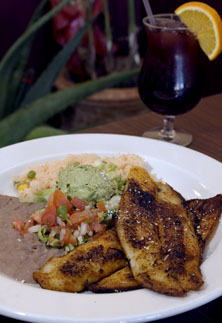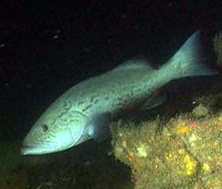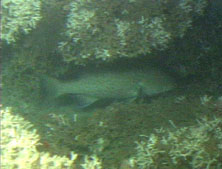Gag (Mycteroperca microlepis)
- Population levels of gag are healthy, but overfishing is occurring.
- Amendments are currently being developed to end overfishing of gag in both the South Atlantic and Gulf of Mexico.
- Grouper is low in saturated fat. It is also a good source of vitamins B6 and B12, phosphorus, and potassium, and a very good source of protein and selenium. For more on nutrition, see Nutrition Facts. (USDA)
- Gag is an important part of the commercial fisheries in the South Atlantic. Recreational harvest is high in both the South Atlantic and Gulf of Mexico.
|
 |
 |
 |
 |
| Nutrition Facts |
| Servings 1 |
| Serving Weight
100g |
 |
| Amount Per Serving |
 |
| Calories 92 |
 |
| Total Fat |
1.02 g |
 |
| Total Saturated Fatty Acids |
0.233 g |
 |
| Carbohydrate |
0 g |
| Sugars |
0 g |
| Total Dietary
Fiber |
0 g |
 |
| Cholesterol |
37 mg |
 |
| Selenium |
36.5 mcg |
 |
| Sodium |
53 mg |
 |
| Protein |
19.38 g |
 |
|
 |
 Gag is the most common grouper in the southeastern United States. Gag is the most common grouper in the southeastern United States.
|
 |
Did you know?
Groupers are particularly vulnerable to overfishing because of their reproductive behaviors. They have complex social systems that lead them to change sex, and they form large groups to spawn for relatively short periods of time. Groupers are caught easily when in these spawning groups.
The species name, microlepis, is derived from the Greek words "micro" for small and "lepis" meaning scale, in reference to the small scales covering the body of this fish.
|
|
| |
 |
|
Gag observed at Steamboat Lumps Marine Reserve in the Gulf of Mexico. This area has been closed to fishing to protect spawning gag.
|
 |
|
Gag under cover of coral. Groupers are the dominant predatory fish on many coral reefs.
|
|
Sustainability Status
Biomass: South Atlantic biomass is 94% of the biomass needed to support maximum sustainable yield (BMSY). Gulf of Mexico biomass is 99% of BMSY.
Overfishing: Yes
Overfished: No (South Atlantic); Undefined (Gulf of Mexico)*
Fishing and habitat: There is little scientific information on the impacts on marine habitats from hook-and-line gear, but habitat impacts appear to be minimal. Numerous Habitat Areas of Particular Concern, marine reserves, and a reef fish stressed are in the Gulf of Mexico have been established to protect and minimize impacts on habitat associated with fishing activities.
Bycatch: The South Atlantic Snapper Grouper Fishery Management Plan (FMP) prohibits the use of trawl gear, fish traps, and bottom longlines inside 50 fathoms to reduce bycatch in the South Atlantic fishery. The South Atlantic Fishery Management Council continues to explore new methods to further reduce bycatch. The Gulf of Mexico Reef Fish FMP prohibits the use of trawl gear, fish traps, and bottom longlines inside 20 fathoms in the eastern Gulf of Mexico and inside 50 fathoms in the western Gulf of Mexico. The FMP also provides measures to reduce bycatch of endangered sea turtles and smalltooth sawfish in the Gulf of Mexico. Recreational and commercial fishermen are also required to use circle hooks, venting tools, and dehooking devices to minimize mortality of reef fish when they are released.
Aquaculture: There is currently no commercial aquaculture of gag in the United States, but this species is considered a good candidate for aquaculture.
*The Gulf of Mexico Fishery Management Council has not approved a new overfished definition for gag; therefore, the stock status is listed as undefined. Based on definitions recently used for other species and results from the latest stock assessment, gag would not be considered overfished.
|
Science and Management
In the South Atlantic, gag is managed as part of the Fishery Management Plan (FMP) for the Snapper Grouper Fishery of the South Atlantic region. FMP regulations include a minimum commercial and recreational size limit of 24 inches total length for gag, gear restrictions, a recreational bag limit, and a provision for the designation of special management zones. Sale and purchase of gag is prohibited in March and April, and harvest is limited to the recreational bag limit.
In 1998, the South Atlantic Fishery Management Council established the "2 for 1" program to address overcapitalization in the snapper grouper fishery. Anyone wishing to enter the commercial fishery must buy two transferable vessel permits in order to qualify for a newly issued permit, thus eliminating one permit each time a new person enters the fishery. This management measure has been effective in reducing participation in the fishery and pressure on the resource. This program will continue until the number of permits has been reduced to an optimum level to be determined based on the long-term yield of the fishery.
In the federal waters of the Gulf of Mexico, gag is managed as part of the shallow-water grouper complex in the Reef Fish FMP. Originally implemented in 1984, the plan currently includes gear restrictions, permits, commercial and recreational minimum size limits of 24 inches and 22 inches total length, respectively, for gag, a commercial quota for groupers, a 5-grouper recreational aggregate bag limit, and data reporting requirements. The FMP also established two marine reserves to protect gag grouper spawning aggregations.
|
Life History and Habitat
Life history, including information on the habitat, growth, feeding, and reproduction of a species, is important because it affects how a fishery is managed. Snapper grouper management is difficult because many of these species are slow growing, late maturing, and long lived, so rebuilding efforts for some species will take years to produce full recovery.
- Geographic range: Adult gag are found from North Carolina to Brazil. The species is found in the Gulf of Mexico but not in the West Indies. Young gag inhabit estuaries from Massachusetts to Cape Canaveral, Florida, along the Atlantic coast and estuaries off west Florida, Louisiana, and Texas in the Gulf of Mexico.
- Habitat: Young gag live in estuaries. Adults are found over low and high profile hard bottom in waters 30 to 500 feet deep. Gag often congregate around rocky ledges.
- Life span: Maximum reported age in the South Atlantic and Gulf of Mexico is 30 years and 31 years, respectively.
- Food: Gag eat round scad, sardines, porgies, snappers, grunts, crabs, shrimp, and squid.
- Growth rate: Slow
- Maximum size: Up to 58 inches in length and 81 pounds in weight.
- Reaches reproductive maturity: Gag is a protogynous species, maturing first as females (half of females are mature at 3.7 years old), and then becoming males (half of males mature at 10.8 years old).
- Reproduction: Gag are protogynous hermaphrodites, which means they begin life as females, but change sex to males as they grow older. Females spawn several times per season. Reproductive potential varies; a recent study found that some females have 60,000 eggs per spawning event while others have up to 1.7 million eggs.
- Spawning season: Spawning takes place from mid-January to early May in the South Atlantic and from late January to mid-April in the Gulf of Mexico.
- Spawning grounds: Gag aggregate to spawn along the shelf edge in both the South Atlantic and Gulf of Mexico. Primary spawning grounds in the Gulf of Mexico are along the west Florida shelf at approximately 200 to 300 feet.
- Migrations: Gag often swim in small groups. As they grow older, they move to deeper water. Juveniles make limited movements before moving to offshore waters to spawn.
- Predators: Adult gag and large fishes prey on juvenile gag. Sharks and other large fishes are predators of adult gag.
- Commercial or recreational interest: Both
- Distinguishing characteristics: Gag have long, compressed bodies. Their coloring varies with the size of the fish. Large gag are dark brownish-gray above and paler below, with traces of dark wavy markings on the sides. Smaller fish are much lighter and have numerous dark brown or charcoal kiss-like marks along the sides. Gag are often confused with black grouper; however, the gag's tail and anal fins have white edges, while black grouper do not.
|
Role in the Ecosystem
|
Additional Information
Market names: Grouper or Gag
Vernacular names: Velvet Rockfish, Small-scaled Rockfish
|
Biomass
 Biomass refers to the amount of gag in the ocean. Scientists cannot collect and weigh every single fish to determine biomass, so they use models to estimate it instead. These biomass estimates can help determine if a stock is being fished too heavily or if it may be able to tolerate more fishing pressure. Managers can then make appropriate changes in the regulations of the fishery. Biomass refers to the amount of gag in the ocean. Scientists cannot collect and weigh every single fish to determine biomass, so they use models to estimate it instead. These biomass estimates can help determine if a stock is being fished too heavily or if it may be able to tolerate more fishing pressure. Managers can then make appropriate changes in the regulations of the fishery.
In the South Atlantic, total and spawning stock biomass (SSB) declined from initial high values in the 1960s to below sustainable levels in the 1980s and continued to decline through the remainder of the 1980s. However, biomass has been increasing since the 1990s.
In the Gulf of Mexico, spawning stock biomass declined during the late 1960s and 1970s and did not increase much until the mid 1990s. Since 1999, spawning stock biomass has remained above 20 million pounds. Estimated total biomass followed a similar pattern with lower levels in the 1980s and an increase in the 1990s. Total biomass was almost 38 million pounds in 2004. Abundance indices updated since the last stock assessment indicate spawning stock biomass and total biomass may have declined after 2004.
Landings
 Landings refer to the amount of catch that is brought to land. Gag is an important commercial species in the South Atlantic. In the snapper/grouper fishery, only landings of black sea bass and vermilion snapper have exceeded gag in recent years. Since 2000, commercial landings of gag have been fairly stable between 550,000 and 600,000 pounds annually. Gag also makes up a large part of the recreational harvest along the southeastern U.S. coast. Recreational fishermen reported an annual catch of more than 300 metric tons (660,000 pounds) in 2003, which exceeded the commercial catches (although the error in recreational catch reporting is often high). Landings refer to the amount of catch that is brought to land. Gag is an important commercial species in the South Atlantic. In the snapper/grouper fishery, only landings of black sea bass and vermilion snapper have exceeded gag in recent years. Since 2000, commercial landings of gag have been fairly stable between 550,000 and 600,000 pounds annually. Gag also makes up a large part of the recreational harvest along the southeastern U.S. coast. Recreational fishermen reported an annual catch of more than 300 metric tons (660,000 pounds) in 2003, which exceeded the commercial catches (although the error in recreational catch reporting is often high).
In the Gulf of Mexico, commercial landings have increased since the late 1990s but only make up a small percentage of total landings. Recreational landings are high. They have almost doubled since the late 1980s, peaking at over 7 million pounds in 2004. Since 2004, both commercial and recreational gag landings have declined.
Biomass and Landings
 Are landings and biomass related? Landings are dependent on biomass, management measures in the fishery, and fishing effort. Are landings and biomass related? Landings are dependent on biomass, management measures in the fishery, and fishing effort.
Data sources:
Biomass and landings from 2006 South Atlantic and Gulf of Mexico Gag Grouper Stock Assessment Report, Final Model for Gulf of Mexico Gag Grouper as Recommended by the SEDAR Grouper Review Panel: Revised results and projections
|
Important Dates
South Atlantic:
1983 – Snapper Grouper Fishery Management Plan (FMP) implemented, establishing gear restrictions, a 4 inch trawl mesh size, and Special Management Zones (SMZs)
1986 – Regulatory Amendment 1 prohibits fishing in SMZs, except with hand-held hook-and-line gear and spearfishing gear
1989 – Amendment 1 prohibits trawl gear to harvest fish south of Cape Hatteras, North Carolina and north of Cape Canaveral, Florida
1991 – Amendment 3 requires a permit to fish for, land, or sell snapper grouper species
1992 – Amendment 4 prohibits fish traps, entanglement nets, longline gear inside 50 fathoms, powerheads, and bangsticks in designated SMZs off South Carolina and establishes a 20 inch minimum size limit for gag and an aggregate grouper bag limit of 5 groupers per person per day
1994 – Amendment 7 requires dealer, charter, and headboat federal permits
1998 – Amendment 8 establishes a limited entry system for the snapper grouper fishery
1999 – Amendment 9 increases the gag minimum size limit from 20 inches total length to 24 inches total length for both recreational and commercial fishermen, prohibits harvest and possession in excess of the bag limit during March and April, prohibits purchase and sale during March and April
1999 – Amendment 11 approves definitions for overfished and overfishing
2004 – Amendment 13A extends the regulation prohibiting fishing for and possessing snapper grouper species within the Oculina Experimental Closed Area
Gulf of Mexico:
1984 – Reef Fish FMP implemented
1990 – Amendment 1 sets a minimum size of 20 inches total length for gag and a five grouper recreational bag limit; also establishes a commercial reef fish vessel permit and a fish trap permit, with a maximum 100 trap per permit limit; a longline and buoy gear boundary at approximately the 50-fathom depth contour west of Cape San Blas, Florida, and the 20-fathom contour east of Cape San Blas, Florida; trawl vessels are limited to the recreational size and daily bag limits of reef fish; entangling nets are prohibited from directly harvesting reef fish; and a framework for specifying total allowable catch
1992 – Amendment 4 establishes a moratorium on the issuance of new commercial reef fish permits for a maximum of three years
1994 – First stock assessment for Gulf of Mexico gag is conducted
1994 – Amendment 5 restricts the use of fish traps in the Gulf of Mexico EEZ
1994 – Amendment 9 extends the commercial reef fish permit moratorium through 1995
1996 – Amendment 11 implements additional permitting requirements and extends commercial reef fish permit moratorium for no more than fiver years or until the end of 2000
1997 – Amendment 14 implements a 10-year phase-out of the fish trap fishery; prohibits use of fish traps west of Cape San Blas, Florida
1998 – Amendment 15 prohibits harvest of reef fish from traps other than permitted reef fish traps, stone crab traps, or spiny lobster traps
1999 – Amendment 17 extends permit moratorium another 5 years through 2005
2000 – To stop overfishing, a regulatory amendment increases commercial size limit for gag from 20 to 24 inches total length and increases the recreational size limit for gag from 20 to 22 inches total length, prohibited commercial harvest and sale of gag from February 15 to March 15 (during peak spawning season), and established two marine reserves closed year-round to fishing for all species under the Council's jurisdiction
2002 – Amendment 19 establishes two marine reserve areas off the Dry Tortugas where fishing for any species or anchoring by fishing vessels is prohibited
2002 – Amendment 20 establishes a three-year moratorium on the issuance of charter and headboat vessel permits in the recreational for-hire reef fish fisheries in the Gulf of Mexico EEZ
2004 – A rebuilding plan is implemented for red grouper, reducing the commercial quota for shallow-water grouper (including gag) and requiring that the entire shallow-water grouper fishery be closed when either the red grouper or shallow-water grouper quota is reached
2005 – An emergency rule establishes trip limits for the commercial grouper fishery until 2006 to reduce adverse economic effects from fishery closure and impacts from hurricanes
2005 – Amendment 22 specifies bycatch reporting methods for the reef fish fishery
2005 – Amendment 24 replaces commercial reef fish permit moratorium with an indefinite limited access system
2006 – A regulatory amendment is implemented establishing a 6,000 pound grouper trip limit
2006 – A regulatory amendment is implemented reducing the red grouper bag limit to one and establishing a recreational seasonal closure for gag, black grouper, and red grouper from February 15 to March 15
2006 – Amendment 25 replaces the charter/headboat permit moratorium with an indefinite limited access system
2008 – Amendment 27 requires commercial and recreational anglers to use circle hooks, venting tools, and dehooking devices when fishing for reef fish
|
Notes and Links
General Information:
South Atlantic Fishery Management Council Fish ID and Regulations for Gag Grouper
Fishery Management:
Fishery Management Plan (FMP) for the Snapper Grouper Fishery of the South Atlantic Region
History of Management for the Snapper Grouper Fishery of the South Atlantic
Gulf of Mexico Reef Fish FMP and Amendments
Reef Fish FMP Regulatory Amendments
Gag History of Management in the Gulf of Mexico
Stock Assessments:
2006 South Atlantic and Gulf of Mexico Gag Grouper Stock Assessment Report
Final Model for Gulf of Mexico Gag Grouper as Recommended by the SEDAR Grouper Review Panel: Revised results and projections
|
| |
|



